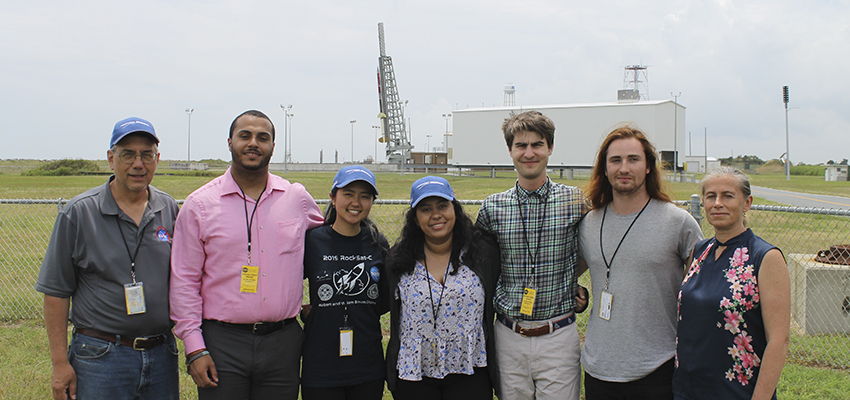
HWS News
6 August 2019 A Soaring Success at NASA
This summer, the RockSat-C team from Hobart and William Smith traveled to NASA’s Wallops Flight Facility in Virginia to watch their hard work and planning launch into space.
During the past year, Shreeya Desai ’21, William Elliman ’20, Victoria Loshusan ’20 and James Truley ’20 designed three subsystems to measure vibration damping, muon flux and magnetic fields of Earth at various altitudes. They were mentored by Associate Professor of Physics Ileana Dumitriu and Physics Lab Technician Peter Spacher Ph.D.
The rocket lifted off at 5:30 a.m. on June 20, and was successfully recovered after it splashed down in the Atlantic Ocean. “I was totally speechless,” says Loshusan, a computer science major. “It was one of the most spectacular things I’ve ever seen.”
Desai, a biology major, explains that “The NASA engineers who were monitoring the flight described it as ‘unremarkable,’ which is good in this case since it means everything went off without a hitch.”
“I enjoyed having the opportunity to meet peers from other institutions and have them share their experiences with me,” says Truley, a physics major. “The experiences that I had at Wallops have definitely shaped where I wish to end up in the future.”
After returning to campus, the team analyzed the data gathered in flight. “We used two of our subsystems to observe some of the Earth’s properties,” explains Elliman, a computer science and physics double major. “The vibration damping subsystem was an attempt to find an effective yet cheap way to send fragile experiments to space.” Once the analysis is complete, the data will be reported to NASA and the RockSat-C program.
Spacher notes that the HWS team was the only one with a payload that passed all tests at Wallops on the first try. “Watching our students interact with other teams and NASA personnel, watching them help other teams troubleshoot problems and seeing them present their work was awe-inspiring,” he says. “It shows growth on personal, professional and technical levels, and gives great confidence that they can succeed at whatever they put their minds to.”
Dumitriu agrees. “We have a bright, hard-working group,” she says. “RockSat-C is a ‘working world’ experience that helps to improve the skills of students who will continue exploring Earth and space.”
On Monday, Aug. 12, a team from HWS will participate in RockSat-X, the most advanced of NASA’s three-phase sounding rocket program for students. The launch of the 44-foot tall suborbital sounding rocket is scheduled between 5:30 and 9:30 a.m. EDT.
Sponsored by NASA and the Colorado Space Grant Consortium, RockSat-C challenges undergraduates to design and develop experimental modules that are launched into space on a suborbital sounding rocket. This is the sixth consecutive year that HWS has been selected to participate in the program; only nine colleges and universities were chosen for the competition this year.
The team recorded their experience through photos, videos, and a blog, available at https://2019hwsrocksatc.wixsite.com/space.
